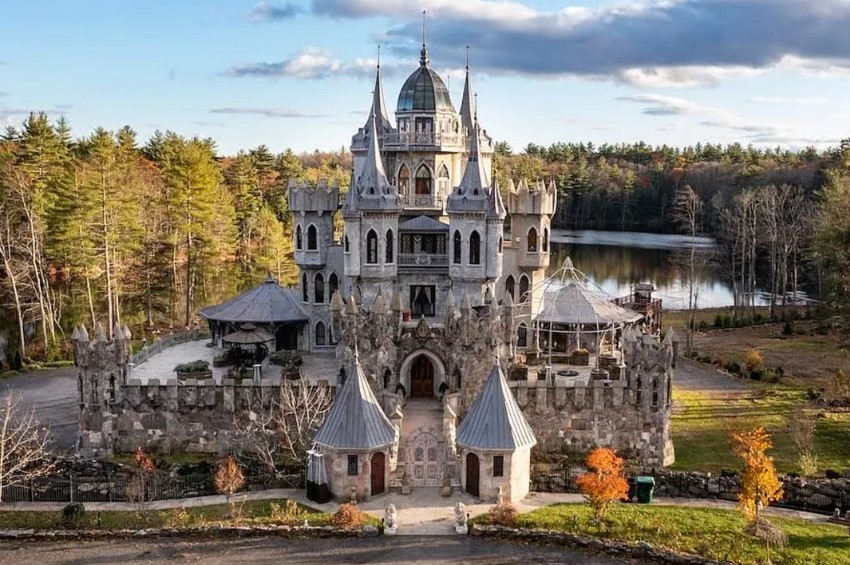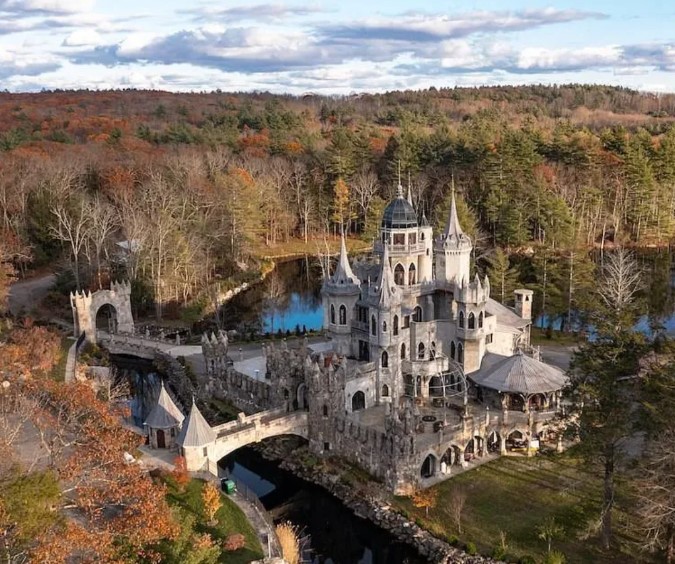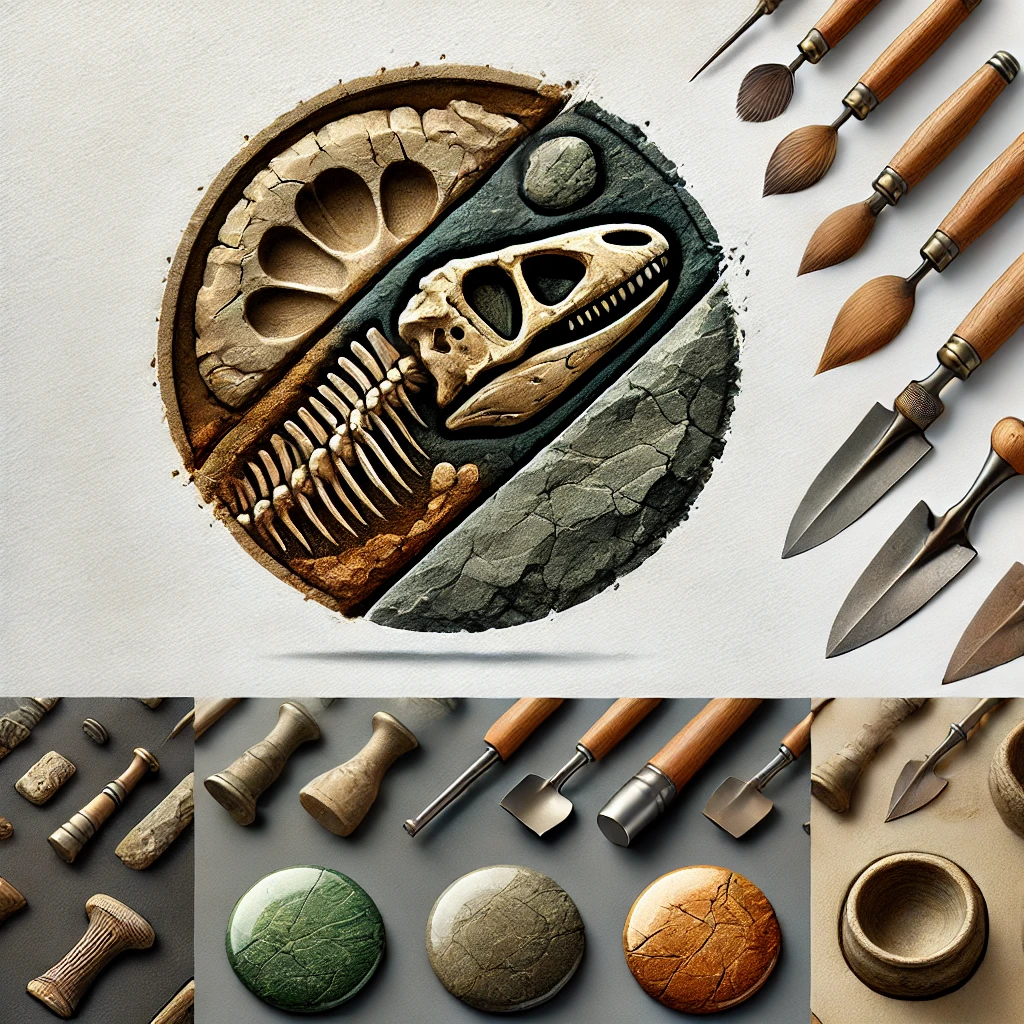Nestled in the heart of an ancient town, the Stone Gothic House is a mesmerizing relic of the past. With its striking architecture and mysterious history, this structure stands as a testament to a bygone era of artistry and grandeur. Let’s explore with archeology.dulichvn.net the stories, craftsmanship, and allure of this Gothic masterpiece, which reveals a world steeped in mystery and cultural heritage.
The Rich History of the Stone Gothic House
The Stone Gothic House is more than just a relic of the past; it’s a window into medieval life, architectural artistry, and the passage of time. With its origins steeped in mystery and a history that spans centuries, this remarkable structure offers a captivating story to all who visit.

1. Origins Shrouded in Mystery
The Stone Gothic House’s beginnings are as enigmatic as its intricate design.
A Timeline Uncertain
Historians and architects estimate that the house was built in the 14th or 15th century, during the zenith of Gothic architecture. Despite extensive research, no definitive records pinpoint its exact construction date, leaving its early years open to speculation.
Masterpieces of Gothic Design
The house embodies key elements of Gothic architecture, such as pointed arches, ornate stone carvings, and ribbed vaults. Its façade is adorned with intricate motifs that reflect the craftsmanship and artistic sophistication of the period.
The Builders Behind the Vision
While the names of its builders remain unknown, it’s believed that skilled stonemasons, influenced by Gothic cathedrals and urban structures of the time, crafted this house. Their work reflects not only their expertise but also the cultural values and aspirations of the medieval era.
2. An Icon of Medieval Urban Life
The Stone Gothic House was more than just a residence; it was a statement of wealth and social standing.
A Residence of the Elite
Evidence suggests that the house was built for a wealthy merchant or a noble family. Its grandiose scale, elaborate carvings, and durable stone construction set it apart from the timber-framed homes common among the lower classes.
Symbol of Prosperity
During the medieval period, houses like this were status symbols. The Stone Gothic House’s grandeur reflected not only the financial success of its owners but also their influence within the community.
A Hub of Activity
The house likely served multiple purposes, combining residential quarters with spaces for commerce or social gatherings. Its location in an urban setting would have placed it at the heart of medieval trade and society.
See more: Carahunge Armenia’s Ancient “Speaking Stones”
3. Changes Through the Centuries
Time has left its mark on the Stone Gothic House, but its core essence endures.
Adaptations to Changing Times
Over the centuries, the house underwent renovations to suit the evolving needs of its occupants. Additions, modifications, and repairs reflect the architectural trends and functional demands of each era, blending Gothic foundations with newer styles.
Cultural Shifts in Design
While its Gothic roots remain unmistakable, later influences—such as Renaissance or Baroque details—can be seen in its structure. These changes provide a layered narrative of the region’s architectural and cultural history.
Preservation Efforts
In modern times, the Stone Gothic House has become a focal point for preservationists and historians. Efforts to maintain its original features have ensured that its beauty and historical significance continue to inspire future generations.
Architectural Marvels of the Gothic Era: The Stone Gothic House
The Stone Gothic House is a masterful representation of Gothic architecture, showcasing the era’s intricate artistry, innovative engineering, and timeless aesthetic. Every detail, from its carved stone façade to its towering roof, tells a story of human creativity and medieval ingenuity. Let’s explore the architectural marvels that make this house a true gem of its time.

1. Striking Stonework and Carvings
The hallmark of Gothic architecture lies in its ability to transform stone into art, and the Stone Gothic House exemplifies this brilliantly.
Elaborate Carvings
The house is adorned with detailed carvings featuring grotesques, floral patterns, and religious iconography. Grotesques, often mistaken for gargoyles, serve both as decorative elements and as symbolic guardians against evil. These intricate designs showcase the incredible craftsmanship of medieval stonemasons, who worked with precision to create a harmonious blend of beauty and symbolism.
Narratives in Stone
Each carving tells a story, from biblical tales to representations of nature and daily life. These motifs not only reflect the spiritual and cultural beliefs of the time but also provide insight into the artistic trends and societal values of the medieval period.
Timeless Durability
The use of high-quality stone ensured the house’s longevity. Despite centuries of exposure to the elements, the carvings have retained their sharpness and detail, standing as a testament to the enduring quality of Gothic design.
2. Vaulted Ceilings and Arched Windows
The interior of the Stone Gothic House is as awe-inspiring as its exterior, offering a glimpse into the grandeur and functionality of Gothic architectural innovation.
Soaring Vaulted Ceilings
The high vaulted ceilings inside the house create an impression of immense space and lightness. This architectural feature, characteristic of Gothic structures, distributes weight evenly, allowing for larger rooms without compromising structural integrity. The result is a breathtaking sense of openness and elevation, evoking feelings of awe and reverence.
Pointed Arches for Structural Strength
The pointed arches, a defining element of Gothic architecture, serve both aesthetic and practical purposes. These arches enhance the visual appeal of the house while providing superior weight distribution, enabling the construction of taller and more complex structures.
Dramatic Light and Shadows
The arched windows, strategically positioned throughout the house, allow natural light to flood the interior. This interplay of light and shadow enhances the enigmatic charm of the house, creating a dynamic and ever-changing atmosphere.
3. The Unique Gothic Roof
The roof of the Stone Gothic House is not just a structural necessity but a crowning achievement in Gothic design.
A Striking Silhouette
The steeply pitched roof contributes to the house’s iconic silhouette, drawing the eye upward and emphasizing the verticality that defines Gothic architecture. This design element gives the house a majestic presence, standing tall against its surroundings.
Practical Engineering
The steep pitch of the roof is not merely decorative; it is a practical response to the challenges of heavy rainfall common in many regions during the Gothic era. The design allows water to drain quickly, reducing the risk of damage to the structure and its foundation.
Ornamental Features
The roof is often embellished with additional Gothic elements such as finials, crockets, and ornate chimneys. These features enhance its visual appeal while demonstrating the attention to detail that characterizes the Gothic style.
See more: The Porte de Paris in Lille: A Triumph of Baroque Architecture and History
The Allure of Forgotten Grandeur
The Stone Gothic House, with its storied past and architectural brilliance, stands as a testament to an era of grand designs and cultural richness. This remarkable structure captivates not just for its historical significance but also for its enduring impact on culture, heritage, and modern creativity. Below, we delve into the facets that make this house an emblem of forgotten grandeur.

1. A Portal to the Past
Walking through the halls of the Stone Gothic House is like stepping into a time capsule.
Immersive Historic Atmosphere
The preserved architecture, from its towering vaulted ceilings to the intricate carvings on its stone façade, evokes a sense of wonder. Each corner of the house tells a story of life in the medieval era, inviting visitors to imagine the daily lives of those who once inhabited its grand spaces.
Tangible Connection to History
Unlike artifacts in a museum, this house offers an immersive experience, allowing visitors to physically connect with history. The grooves worn into stone steps and the aged patina on wooden beams speak to centuries of use, providing a tactile link to the past.
An Educational Treasure
For historians and enthusiasts, the house serves as a rich resource for understanding the Gothic era. Its design reflects the cultural, technological, and artistic achievements of a time when craftsmanship was both a necessity and an art form.
2. A Site of Cultural Significance
The Stone Gothic House is more than an architectural marvel; it’s a cultural beacon.
Preserving Heritage
This historic house stands as a symbol of resilience, having weathered centuries of change. Its continued existence underscores the importance of preservation and the role it plays in maintaining a community’s cultural identity.
A Hub for Exploration
Today, the house attracts a diverse array of visitors—historians seeking knowledge, architects studying its design, and tourists enchanted by its beauty. Each visitor contributes to the house’s ongoing story, ensuring its relevance for generations to come.
Encouraging Community Pride
For local communities, the house is a point of pride and an enduring symbol of their shared heritage. It serves as a rallying point for cultural initiatives and preservation efforts, fostering a collective appreciation for history.
3. An Inspiration for Modern Design
The Stone Gothic House continues to leave its mark on contemporary architecture and design.
Timeless Aesthetics
Elements such as pointed arches, elaborate stone carvings, and high vaulted ceilings remain timeless design features. Modern architects often draw inspiration from these Gothic elements, incorporating them into everything from grand public buildings to private residences.
Innovative Engineering Principles
The house’s ingenious use of weight distribution and structural supports is still studied today. Its ability to combine aesthetic appeal with practical functionality highlights engineering principles that remain relevant in modern construction.
Blending Past and Present
Incorporating Gothic motifs into contemporary spaces creates a bridge between history and modernity. The fusion of these styles breathes new life into age-old designs, ensuring their legacy continues in innovative ways.
Preserving the Legacy of the Stone Gothic House
The Stone Gothic House stands as a beacon of history and culture, but preserving such a timeless structure comes with its own set of challenges. Efforts to maintain its grandeur and significance require collaboration, innovation, and a vision for the future.

1. Challenges in Conservation
Preserving a centuries-old structure like the Stone Gothic House is no small feat.
Natural Wear and Tear
The passage of time inevitably takes a toll on historic buildings. Exposure to harsh weather conditions, including rain, snow, and temperature fluctuations, gradually erodes the intricate stonework and weakens the structural integrity of the house.
The Impact of Modern Pollution
Urbanization and industrial activity have introduced new threats to historic buildings. Acid rain and air pollution accelerate the deterioration of the house’s stone façade, creating an urgent need for protective measures and regular maintenance.
Balancing Preservation and Accessibility
Conserving the house while making it accessible to visitors presents a unique challenge. Restoration work must strike a delicate balance between preserving the original materials and implementing modern reinforcements to ensure safety and durability.
2. Community and Heritage Efforts
The survival of the Stone Gothic House is largely thanks to the dedication of local communities and heritage organizations.
Grassroots Fundraising
From bake sales to art auctions, local communities have organized creative fundraising events to generate the resources needed for restoration projects. Their efforts not only raise money but also foster a sense of pride and ownership among residents.
Collaborative Restoration Projects
Heritage organizations often partner with architects, historians, and conservationists to carry out meticulous restoration work. These collaborative efforts ensure that the house’s historical accuracy is preserved while addressing its structural needs.
Public Awareness Campaigns
Educational initiatives and public campaigns play a crucial role in safeguarding the house’s future. By sharing its history and significance, these efforts inspire people to support preservation initiatives and advocate for the protection of other historical landmarks.
3. A Vision for the Future
Looking ahead, the focus is not only on preserving the Stone Gothic House but also on enriching its legacy.
Digital Preservation and Archives
Advanced technology is being used to create digital models and archives of the house. These tools allow historians, architects, and the general public to explore the building in detail, ensuring its story is preserved even if the physical structure faces unforeseen challenges.
Engaging Guided Tours
Interactive tours, both in-person and virtual, offer visitors a chance to experience the house’s rich history firsthand. These tours provide insights into the Gothic era, the house’s architectural significance, and the cultural narratives it embodies.
Educational Programs and Outreach
Collaborations with schools, universities, and cultural institutions ensure that the story of the Stone Gothic House reaches younger generations. Workshops, lectures, and hands-on activities inspire a new wave of preservationists who will carry forward the house’s legacy.
Conclusion
The Stone Gothic House stands as more than just a building; it is a bridge to the past, a masterpiece of design, and a symbol of cultural resilience. Its towering façade, intricate carvings, and enduring mystery make it a beacon of Gothic architecture. As we strive to preserve its legacy, we are reminded of the profound impact of history and art on our collective identity.
Whether you are a history enthusiast, an architecture lover, or simply someone captivated by the beauty of the past, the Stone Gothic House invites you to discover its enigmatic story and celebrate the grandeur of a forgotten era.

CÁC TIN KHÁC
Mary Walton: The Forgotten Inventor Who Helped Clean Up America’s Cities
Tomb of Queen Nefertari in the Valley of the Queens, Egypt
Discover the Hypostyle Hall of the Temple of Hathor at Dendera
Venus de Losange: Unveiling the Mystery of a 20,000-Year-Old Paleolithic Icon